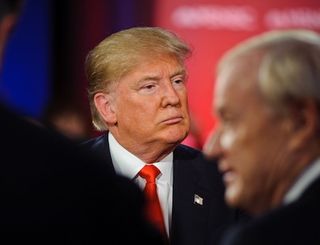Industry Analysts Lower Political Ad Forecasts

On the heels of station groups changing their political ad forecasts, industry analysts Thursday said they too expect local TV to get less than the $3.3 billion previously predicted.
In two separate presentations at the TVB Forward Conference in New York, Wells Fargo’s Marci Ryvicker and Steve Passwaiter, Kantar Media VP and general manager, said political revenue will come in below the $3 billion mark.
Ryvicker’s revised forecast calls for political revenue to hit $2.65 billion—53% of the $5 billion total she expects campaigns to spend across mediums. Passwaiter expects $2.8 billion to be local TV’s magic number.
Ryvicker and Passwaiter both credited the lowered forecasts to this year’s unorthodox presidential campaign—most notably Donald Trump’s lack of advertising—rather than a more widespread declining interest in local TV. Ryvicker said broadcast TV is still “must see.”
Less than two weeks ago, Sinclair Broadcast Group lowered its political forecast and Gray Television withdrew its 3Q guidance altogether for similar reasons.
“Nobody is debating about broadcast,” Passwaiter said. “None of these guys are on a suicide mission. Your place at the top of the table is still there.”
Although the Trump campaign is in the midst of rolling out a $140 million campaign, the candidate has spent just $78 million on TV so far—a far cry from the $550 million Republican candidate Mitt Romney spent in 2012, Passwaiter said.
Broadcasting & Cable Newsletter
The smarter way to stay on top of broadcasting and cable industry. Sign up below
Hillary Clinton’s campaign, on the other hand, has already spent $325 million on spot TV. President Obama’s campaign spent $500 million on the medium in 2012.
“In modern day history, this has never been done,” Passwaiter said. “If we took the word ‘unprecedented’ out of the English language we would have nothing to say about this presidential election.”
With competitors like Google and Facebook chomping at the bit, however, broadcasters can’t be lackadaisical, he said.
“It is a great time to remind these guys just how many voters you drive to the polls because they are hearing very different stories,” Passwaiter said. “And unfortunately the volume with which that story is being told” is high, he said.
